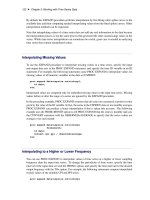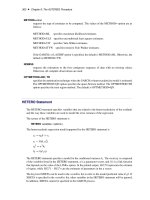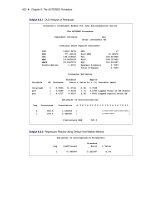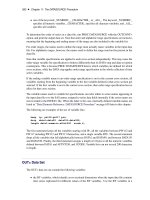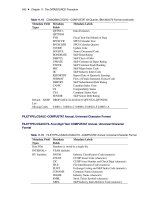SAS/ETS 9.22 User''''s Guide 61 potx
Bạn đang xem bản rút gọn của tài liệu. Xem và tải ngay bản đầy đủ của tài liệu tại đây (187.16 KB, 10 trang )
592 ✦ Chapter 11: The DATASOURCE Procedure
one of the keywords _NUMERIC_, _CHARACTER_, or _ALL_. The keyword _NUMERIC_
specifies all numeric variables, _CHARACTER_ specifies all character variables, and _ALL_
specifies all variables.
To determine the order of series in a data file, run PROC DATASOURCE with the OUTCONT=
option, and print the output data set. Note that order and alphabetic range specifications are inclusive,
meaning that the beginning and ending names of the range are also included in the variable list.
For order ranges, the names used to define the range must actually name variables in the input data
file. For alphabetic ranges, however, the names used to define the range need not be present in the
data file.
Note that variable specifications are applied to each cross section independently. This may cause the
order-range variable list specification to behave differently than its DATA step and data set option
counterparts. This is because PROC DATASOURCE knows which variables are defined for which
cross sections, while the DATA step applies order range specification to the whole collection of time
series variables.
If the ending variable name in an order range specification is not in the current cross section, all
variables starting from the beginning variable to the last variable defined in that cross section get
selected. If the first variable is not in the current cross section, then order range specification has no
effect for that cross section.
The variable names used in variable list specifications can refer either to series names appearing in
the input data file or to the SAS names assigned to series data fields internally if the series names are
not recorded to the INFILE= file. When the latter is the case, internally defined variable names are
listed in “Data Elements Reference: DATASOURCE Procedure” on page 630 later in this chapter.
The following are examples of the use of variable lists:
keep ip: pw112-pw117 pzu;
drop data1-data99 data151-data350;
length data1-numeric-aftnt350 ucode 4;
The first statement keeps all the variables starting with IP:, all the variables between PW112 and
PW117 including PW112 and PW117 themselves, and a single variable PZU. The second statement
drops all the variables that fall alphabetically between DATA1 and DATA99, and between DATA151
and DATA350. Finally, the third statement assigns a length of 4 bytes to all the numeric variables
defined between DATA1 and AFTNT350, and UCODE. Variable lists can not exceed 200 characters
in length.
OUT= Data Set
The OUT= data set can contain the following variables:
the BY variables, which identify cross-sectional dimensions when the input data file contains
time series replicated for different values of the BY variables. Use the BY variables in a
OUT= Data Set ✦ 593
WHERE statement to process the OUT= data set by cross sections. The order in which BY
variables are defined in the OUT= data set corresponds to the order in which the data file is
sorted.
DATE, a SAS date-, time-, or datetime-valued variable that reports the time period of each
observation. The values of the DATE variable may span different time ranges for different BY
groups. The format of the DATE variable depends on the INTERVAL= option.
the periodic time series variables, which are included in the OUT= data set only if they
have data in at least one selected BY group and they are not discarded by a KEEP or DROP
statement
the event variables, which are included in the OUT= data set if they are not discarded by a
KEEP or DROP statement. By default, these variables are not output to OUT= data set.
The values of BY variables remain constant in each cross section. Observations within each BY
group correspond to the sampling of the series variables at the time periods indicated by the DATE
variable.
You can create a set of single indexes for the OUT= data set by using the INDEX option, provided
there are BY variables. Under some circumstances, this may increase the efficiency of subsequent
PROC and DATA steps that use BY and WHERE statements. However, there is a cost associated with
creation and maintenance of indexes. The SAS Language Reference: Concepts lists the conditions
under which the benefits of indexes outweigh the cost.
With data files containing cross sections, there can be various degrees of overlap among the series
variables. One extreme is when all the series variables contain data for all the cross sections. In this
case, the output data set is very compact. In the other extreme case, however, the set of time series
variables are unique for each cross section, making the output data set very sparse, as depicted in
Table 11.4.
Table 11.4 The OUT= Data Set Containing Unique Series for Each BY Group
BY Series in Series in : : : Series in
Variables first BY group second BY group : : : last BY group
BY1 : : : BYP F1 F2 F3 : : : FN S1 S2 S3 : : : SM : : : T1 T2 T3 : : : TK
BY DATA
group is
1 here
BY DATA data is missing
group is everywhere except
2 here on diagonal
DATA
:
:
: is
here
BY DATA
group is
N here
594 ✦ Chapter 11: The DATASOURCE Procedure
The data in Table 11.4 can be represented more compactly if cross-sectional information is incorpo-
rated into series variable names.
OUTCONT= Data Set
The OUTCONT= data set contains descriptive information for the time series variables. This
descriptive information includes various attributes of the time series variables. The OUTCONT=
data set contains the following variables:
NAME, a character variable that contains the series name
KEPT, a numeric variable that indicates whether the series was selected for output by the
DROP or KEEP statements. KEPT is usually the same as SELECTED, but can differ if a
WHERE statement is used.
SELECTED, a numeric variable that indicates whether the series is selected for output to the
OUT= data set. The series is included in the OUT= data set (SELECTED=1) if it is kept
(KEPT=1) and it has data for at least one selected BY group.
TYPE, a numeric variable that indicates the type of the time series variable. TYPE=1 for
numeric series; TYPE=2 for character series.
LENGTH, a numeric variable that gives the number of bytes allocated for the series variable
in the OUT= data set
VARNUM, a numeric variable that gives the variable number of the series in the OUT= data
set. If the series variable is not selected for output (SELECTED=0), then VARNUM has a
missing value. Likewise, if no OUT= option is given, VARNUM has all missing values.
LABEL, a character variable that contains the label of the series variable. LABEL contains
only the first 256 characters of the labels. If they are longer than 256 characters, then the
variable, DESCRIPT, is defined to hold the whole length of series labels. Note that if a data
file assigns different labels to the same series variable within different cross sections, only the
first occurrence of labels will be transferred to the LABEL column.
the variables FORMAT, FORMATL, and FORMATD, which give the format name, length,
and number of format decimals, respectively
the GENERIC variables, whose values may vary from one series to another, but whose values
remain constant across BY groups for the same series
By default, the OUTCONT= data set contains observations for only the selected series where
SELECTED=1. If the OUTSELECT=OFF option is specified, the OUTCONT= data set contains
one observation for each unique series of the specified periodicity contained in the input data file.
If you do not know what series are in the data file, you can run PROC DATASOURCE with the
OUTCONT= option and OUTSELECT=OFF. The information contained in the OUTCONT= data
set can then help you to determine which time series data you want to extract.
OUTBY= Data Set ✦ 595
OUTBY= Data Set
The OUTBY= data set contains information on the cross sections contained in the input data file.
These cross sections are represented as BY groups in the OUT= data set. The OUTBY= data set
contains the following variables:
the BY variables, whose values identify the different cross sections in the data file. The BY
variables depend on the file type.
BYSELECT, a numeric variable that reports the outcome of the WHERE statement condition
for the BY variable values for this observation. The value of BYSELECT is 1 for BY groups
selected by the WHERE statement for output to the OUT= data set and is 0 for BY groups that
are excluded by the WHERE statement. BYSELECT is added to the data set only if a WHERE
statement is given. When there is no WHERE statement, then all the BY groups are selected.
ST_DATE, a numeric variable that gives the starting date for the BY group. The starting date
is the earliest of the starting dates of all the series that have data for the current BY group.
END_DATE, a numeric variable that gives the ending date for the BY group. The ending date
is the latest of the ending dates of all the series that have data for the BY group.
NTIME, a numeric variable that gives the number of time periods between ST_DATE and
END_DATE, inclusive. Usually, this is the same as NOBS, but they differ when time periods
are not equally spaced and when the OUT= data set is not specified. NTIME is a maximum
limit on NOBS.
NOBS, a numeric variable that gives the number of time series observations in the OUT= data
set between ST_DATE and END_DATE inclusive. When a given BY group is discarded by a
WHERE statement, the NOBS variable corresponding to this BY group becomes 0, since the
OUT= data set does not contain any observations for this BY group. Note that BYSELECT=0
for every discarded BY group.
NINRANGE, a numeric variable that gives the number of observations in the range (from,to )
defined by the RANGE statement. This variable is only added to the OUTBY= data set when
the RANGE statement is specified.
NSERIES, a numeric variable that gives the total number of unique time series variables
having data for the BY group
NSELECT, a numeric variable that gives the total number of selected time series variables
having data for the BY group
the generic variables, whose values remain constant for all the series in the current BY group
In this list, you can only control the attributes of the BY and GENERIC variables.
The variables NOBS, NTIME, and NINRANGE give observation counts, while the variables
NSERIES and NSELECT give series counts.
596 ✦ Chapter 11: The DATASOURCE Procedure
By default, observations for only the selected BY groups (where BYSELECT=1) are output to the
OUTBY= data set, and the date and time range variables are computed over only the selected time
series variables. If the OUTSELECT=OFF option is specified, the OUTBY= data set contains an
observation for each BY group, and the date and time range variables are computed over all the time
series variables.
For file types that have no BY variables, the OUTBY= data set contains one observation giving
ST_DATE, END_DATE, NTIME, NOBS, NINRANGE, NSERIES, and NSELECT for all the series
in the file.
If you do not know the BY variable names or their possible values, you can do an initial run of PROC
DATASOURCE with the OUTBY= option. The information contained in the OUTBY= data set can
help you design your WHERE expression and RANGE statement for the subsequent executions of
PROC DATASOURCE to obtain different subsets of the same data file.
OUTALL= Data Set
The OUTALL= data set combines and expands the information provided by the OUTCONT= and
OUTBY= data sets. That is, the OUTALL= data set not only reports the OUTCONT= information
separately for each BY group, but also reports the OUTBY= information separately for each series.
Each observation in the OUTBY= data set gets expanded to NSERIES or NSELECT observations in
the OUTALL= data set, depending on whether the OUTSELECT=OFF option is specified.
By default, only the selected BY groups and series are included in the OUTALL= data set. If the
OUTSELECT=OFF option is specified, then all the series within all the BY groups are reported.
The OUTALL= data set contains all the variables defined in the OUTBY= and OUTCONT= data
sets and also contains the GENERIC variables (whose values can vary from one series to another
and from one BY group to another). Another additional variable is BLKNUM, which gives the data
block number in the data file containing the series variable.
The OUTALL= data set is useful when BY groups do not contain the same time series variables or
when the time ranges for series change across BY groups.
You should be careful in using the OUTALL= option, since the OUTALL= data set can get very large
for many file types. Some file types have the same series and time ranges for each BY group; the
OUTALL= option should not be used with these file types. For example, you should not specify
the OUTALL= option with COMPUSTAT files, since all the BY groups contain the same series
variables.
The OUTALL= and OUTCONT= data sets are equivalent when there are no BY variables, except
that the OUTALL= data set contains extra information about the time ranges and observation counts
of the series variables.
OUTEVENT= Data Set ✦ 597
OUTEVENT= Data Set
The OUTEVENT= data set is used to output event-oriented time series data. Events occurring at
discrete points in time are recorded along with the date they occurred. Only CRSP stock files contain
event-oriented time series data. For all other types of files, the OUTEVENT= option is ignored.
The OUTEVENT= data set contains the following variables:
the BY variables, which identify cross-sectional dimensions when the input data file contains
time series replicated for different values of the BY variables. Use the BY variables in a
WHERE statement to process the OUTEVENT= data set by cross sections. The order in which
BY variables are defined in the OUTEVENT= data set corresponds to the order in which the
data file is sorted.
DATE, a SAS date-, time- or datetime-valued variable that reports the discrete time periods at
which events occurred. The format of the DATE variable depends on the INTERVAL= option,
and should accurately report the date based on the SAS YEARCUTOFF option. The default
value for YEARCUTOFF is 1920. The dates used can span up to 250 years.
EVENT, a character variable that contains the event group name. The EVENT variable is
another cross-sectional variable.
the event variables, which are included in the OUTEVENT= data set only if they have data in
at least one selected BY group, and are not discarded by a KEEPEVENT or DROPEVENT
statement
Note that each event group contains a nonoverlapping set of event variables; therefore, the OUT-
EVENT= data set is very sparse. You should exercise care when selecting event variables to be
included in the OUTEVENT= data set.
Also note that even though the OUTEVENT= data set cannot contain any periodic time series
variables, the OUT= data set can contain event variables if they are explicitly specified in a KEEP
statement. In summary, you can specify event variables in a KEEP statement, but you cannot specify
periodic time series variables in a KEEPEVENT statement.
While variable selection for OUT= and OUTEVENT= data sets are controlled by a different set of
statements (KEEP versus KEEPEVENT or DROP versus DROPEVENT), cross-section and range
selections are controlled by the same statements, so in summary, the WHERE and the RANGE
statements are effective for both output data sets.
598 ✦ Chapter 11: The DATASOURCE Procedure
Examples: DATASOURCE Procedure
Example 11.1: BEA National Income and Product Accounts
In this example, exports and imports of goods and services are extracted to demonstrate how to work
with a National Income and Product Accounts (NIPA) file.
From the “Statistical Tables” published by the United States Department of Commerce, Bureau of
Economic Analysis, the relation of foreign transactions in the Balance of Payments Accounts (BPA)
are given in the fifth table (TABNUM=’05’) of the “Foreign Transactions” section (PARTNO=’4’).
Moreover, the first line in the table gives BPAs, while the eighth gives exports of goods and services.
The series names __00100 and __00800, are constructed by two underscores followed by three digits
as the line numbers, and then two digits as the column numbers.
The following statements put this information together to extract quarterly BPAs and exports from a
BEANIPA type file:
/
*
- assign fileref to the external file to be processed
*
/
filename ascifile 'beanipa.data' recfm=v lrecl=108;
title1 'Relation of Foreign Transactions to Balance of Payment Accounts';
title2 'Range from 1984 to 1989';
title3 'Annual';
proc datasource filetype=beanipa infile=ascifile
interval=year
outselect=off
outkey=byfor4;
range from 1984 to 1989;
keep __00100 __00800;
label __00100='Balance of Payment Accounts';
label __00800='Exports of Goods and Services';
rename __00100=BPAs __00800=exports;
run;
proc print data=byfor4;
run;
/
*
- assign fileref to the external file to be processed
*
/
filename ascifile 'beanipa.data' recfm=v lrecl=108;
title1 'Relation of Foreign Transactions to Balance of Payment Accounts';
title2 'Range from 1984 to 1989';
Example 11.1: BEA National Income and Product Accounts ✦ 599
title3 'Annual';
proc datasource filetype=beanipa infile=ascifile
interval=year
outselect=off
outkey=byfor4
out=foreign4;
range from 1984 to 1989;
keep __00100 __00800;
label __00100='Balance of Payment Accounts';
label __00800='Exports of Goods and Services';
rename __00100=BPAs __00800=exports;
run;
proc contents data=foreign4;
run;
proc print data=foreign4;
run;
The results are shown in Output 11.1.1, Output 11.1.2, and Output 11.1.3.
600 ✦ Chapter 11: The DATASOURCE Procedure
Output 11.1.1 Listing of OUTBY=byfor4 of the BEANIPA Data
Relation of Foreign Transactions to Balance of Payment Accounts
Range from 1984 to 1989
Annual
Obs PARTNO TABNUM ST_DATE END_DATE NTIME NOBS NINRANGE NSERIES NSELECT
1 1 07 1929 1989 61 0 6 2 0
2 1 14 1929 1989 61 0 6 1 0
3 1 15 1929 1989 61 0 6 1 0
4 1 20 1967 1989 23 23 6 2 1
5 1 23 1929 1989 61 0 6 2 0
6 2 04 1929 1989 61 0 6 1 0
7 2 05 1929 1989 61 0 6 2 0
8 3 05 1929 1989 61 0 6 1 0
9 3 14 1952 1989 38 0 6 2 0
10 3 15 1952 1989 38 0 6 7 0
11 3 16 1952 1989 38 0 6 1 0
12 4 05 1946 1989 44 44 6 1 1
13 5 07 1929 1989 61 0 6 1 0
14 5 09 1929 1989 61 0 6 1 0
15 6 04 1929 1989 61 0 6 3 0
16 6 05 1929 1948 20 0 0 2 0
17 6 07 1929 1948 20 0 0 1 0
18 6 08 1929 1989 61 0 6 3 0
19 6 09 1948 1989 42 0 6 1 0
20 6 10 1929 1948 20 0 0 1 0
21 6 14 1929 1948 20 0 0 1 0
22 6 19 1929 1948 20 0 0 1 0
23 6 20 1929 1989 61 0 6 2 0
24 6 22 1929 1989 61 0 6 2 0
25 6 23 1948 1989 42 0 6 1 0
26 6 24 1948 1989 42 0 6 1 0
27 7 09 1929 1989 61 0 6 1 0
28 7 10 1929 1989 61 0 6 2 0
29 7 13 1959 1989 31 0 6 1 0
Output 11.1.2 CONTENTS of OUT=foreign4 of the BEANIPA Data
Relation of Foreign Transactions to Balance of Payment Accounts
Range from 1984 to 1989
Annual
The CONTENTS Procedure
Alphabetic List of Variables and Attributes
# Variable Type Len Format Label
3 DATE Num 4 YEAR4. Date of Observation
1 PARTNO Char 1 Part Number of Publication, IntegerPortion
of the Table Number, 1-9
2 TABNUM Char 2 Table Number Within Part, DecimalPortion
of the Table Number, 1-24
4 exports Num 5 Exports of Goods and Services
Example 11.2: BLS Consumer Price Index Surveys ✦ 601
Output 11.1.3 Listing of OUT=foreign4 of the BEANIPA Data
Relation of Foreign Transactions to Balance of Payment Accounts
Range from 1984 to 1989
Annual
Obs PARTNO TABNUM DATE exports
1 1 20 1984 44
2 1 20 1985 53
3 1 20 1986 46
4 1 20 1987 40
5 1 20 1988 48
6 1 20 1989 47
7 4 05 1984 3835
8 4 05 1985 3709
9 4 05 1986 3965
10 4 05 1987 4496
11 4 05 1988 5520
12 4 05 1989 6262
This example illustrates the following features:
You need to know the series variables names used by a particular vendor in order to construct
the KEEP statement.
You need to know the BY-variable names and their values for the required cross sections.
You can use RENAME and LABEL statements to associate more meaningful names and labels
with your selected series variables.
Example 11.2: BLS Consumer Price Index Surveys
This example compares changes of the prices in medical care services with respect to different regions
for all urban consumers (SURVEY=’CU’) since May 1975. The source of the data is the Consumer
Price Index Surveys distributed by the U.S. Department of Labor, Bureau of Labor Statistics.
An initial run of PROC DATASOURCE gives the descriptive information on different regions
available (the OUTBY= data set), as well as the series variable name corresponding to medical care
services (the OUTCONT= data set).

